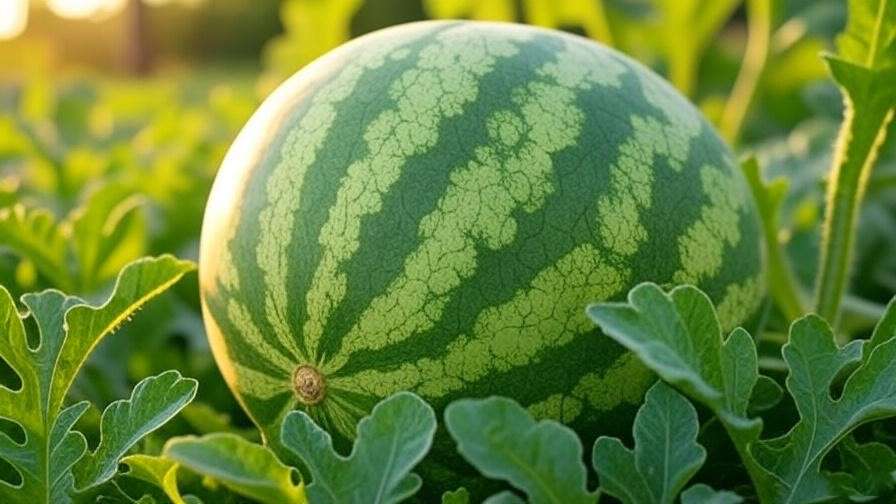Picture this: a lush, compact plant bursting with vibrant Watermelon Berry fruits, their red and white speckled skin resembling tiny watermelons, ready to delight your taste buds with sweet-tart goodness! 🌿✨ Whether you’re a seasoned gardener or a beginner with a small balcony, growing Watermelon Berry plants is a rewarding journey that combines beauty and bounty. In this comprehensive guide, we’ll walk you through everything you need to know to cultivate thriving Watermelon Berry plants, from planting to harvesting. Backed by horticultural expertise and years of hands-on experience, this article delivers actionable tips to ensure vibrant yields. Let’s dive into the world of Fragaria vesca and transform your garden into a berry haven! 🧑🌾🍇
What is a Watermelon Berry? An Overview 🌼
Botanical Background
The Watermelon Berry, often a variety of Fragaria vesca like ‘Mara des Bois’ or hybrid alpine strawberries, is a charming plant known for its compact growth and everbearing fruit production. These berries, with their distinctive red and white markings, resemble miniature watermelons, making them a visual delight in any garden. Unlike traditional strawberries, Watermelon Berries are smaller, typically growing to 6–12 inches tall, and thrive in diverse settings, from backyard plots to urban patios. Their everbearing nature means they produce fruit throughout the growing season, offering a steady supply of sweet, aromatic berries. 🌸
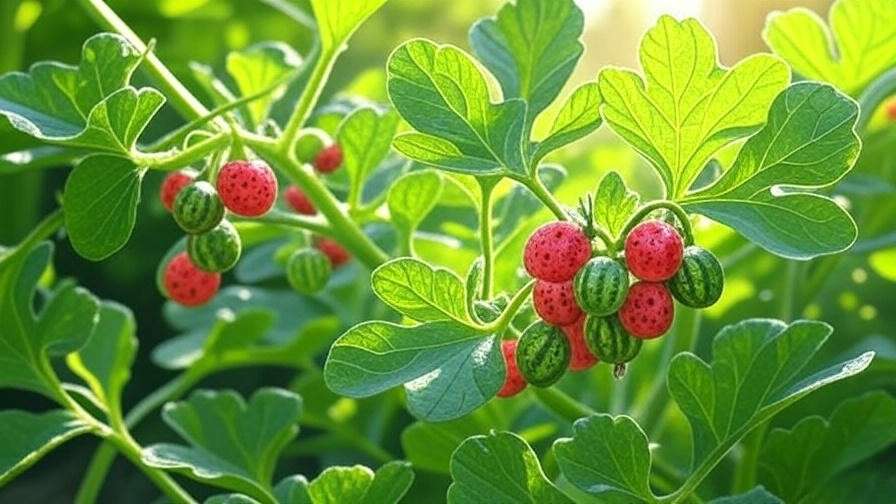
Why Choose Watermelon Berry?
Why opt for Watermelon Berry over other fruits? For starters, they’re incredibly versatile, perfect for small spaces, containers, or even hanging baskets. Their sweet-tart flavor rivals traditional strawberries, but they’re often more disease-resistant and easier to maintain. These plants also double as ornamental additions, with lush green foliage and delicate white flowers that bloom repeatedly. Fun fact: Alpine strawberries, the ancestors of many Watermelon Berry hybrids, have been cultivated in Europe since the 18th century, prized for their intense flavor and compact size. 🍓📜
Preparing to Grow Your Watermelon Berry Plant 🌱
Choosing the Right Variety
Selecting the right Watermelon Berry variety is key to success. Popular options include ‘Mara des Bois,’ known for its rich flavor, and ‘Alpine Red,’ which boasts vibrant coloration. For a unique twist, consider ‘Pineberry,’ a white strawberry with red seeds that mimics the watermelon aesthetic. Always purchase from reputable nurseries to ensure disease-free stock. Expert Tip: Check for certifications like “virus-indexed” plants to avoid common strawberry pathogens. Look for healthy, green foliage and avoid plants with wilted or yellowing leaves. 🏪✅
Ideal Growing Conditions
Watermelon Berries thrive in well-draining, slightly acidic soil with a pH of 5.5–6.5. Test your soil using a home pH kit (available at garden centers for $5–10) to ensure optimal conditions. These plants crave 6–8 hours of direct sunlight daily, though they tolerate partial shade in hotter climates. They’re hardy in USDA zones 4–9, making them adaptable to most regions. In colder areas, protect roots with mulch; in warmer climates, provide afternoon shade to prevent heat stress. Example: Mix equal parts peat moss, compost, and loamy soil for a perfect growing medium. ☀️🧪
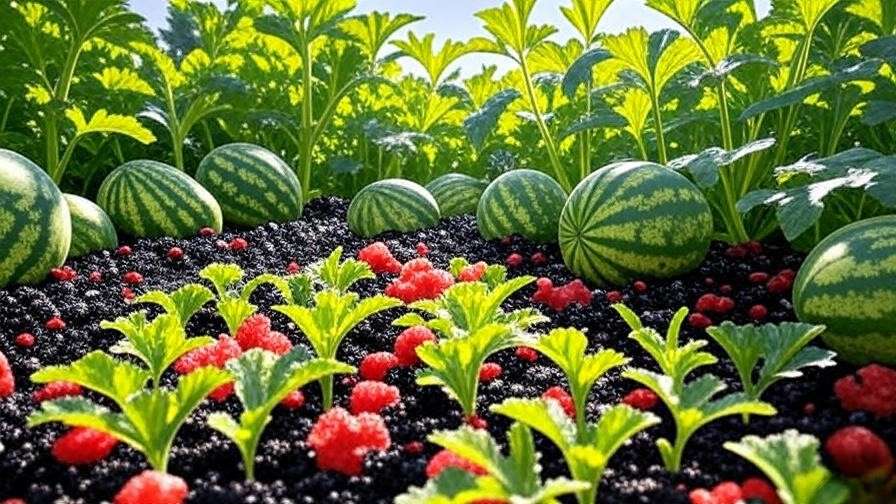
Tools and Supplies You’ll Need
To start, gather these essentials: 10–12-inch pots with drainage holes, a high-quality potting mix, a balanced 10-10-10 fertilizer, organic mulch (like straw or pine needles), and a watering can or drip irrigation system. Budget-conscious gardeners can repurpose containers, while enthusiasts might invest in self-watering pots for convenience. A trowel, gardening gloves, and pruning shears round out the toolkit. Pro Tip: A moisture meter ($10–15) can help monitor soil dampness, preventing overwatering. 🛠️💰
Planting Your Watermelon Berry: Step-by-Step Guide 🌿
When and Where to Plant
The best time to plant Watermelon Berries is early spring or fall, when temperatures are mild (50–70°F). Choose a location with ample sunlight and good air circulation to reduce disease risk. Raised beds, containers, or hanging baskets work well, especially for small spaces. Space plants 15–18 inches apart to allow for runner growth. Visual Aid: Imagine planting at a depth where the crown (where roots meet stems) sits just above the soil surface—too deep risks rot, too shallow stunts growth. 📅🪴

Planting Techniques
For bare-root plants, soak roots in water for 1–2 hours before planting. Dig a hole twice the width of the root ball, place the plant, and backfill with a compost-enriched soil mix. For potted plants, gently loosen the root ball and plant at the same depth as the nursery pot. If starting from seeds, sow them 1/4 inch deep in trays and transplant seedlings after 6–8 weeks. Water thoroughly after planting. Pro Tip: Add a handful of worm castings to the planting hole for a nutrient boost. 🌱🐄
Container Gardening for Watermelon Berry
Containers are a game-changer for Watermelon Berry growers, especially in urban settings. Choose pots at least 10–12 inches deep with drainage holes to prevent waterlogging. Fill with a mix of potting soil and perlite for aeration. Containers allow easy relocation to optimize sunlight or protect from frost. Example: Create a strawberry tower by stacking three pots of decreasing sizes, planting Watermelon Berries in each layer for a space-saving, high-yield display. 🪣🏯
Caring for Your Watermelon Berry Plant 🧑🌾
Watering Needs
Watermelon Berries need consistent moisture—about 1–2 inches of water per week, depending on climate. Water deeply at the base, avoiding foliage to prevent fungal issues. Overwatering leads to soggy roots and rot, while underwatering causes wilting and reduced fruiting. Check soil moisture by inserting a finger 1 inch deep; if dry, water immediately. Expert Insight: Drip irrigation or soaker hoses deliver water efficiently, saving time and reducing waste. A morning watering routine helps plants dry out before nightfall. 💧🚿
Fertilizing for Success
Feed your Watermelon Berry plants monthly during the growing season with a balanced 10-10-10 fertilizer or organic alternatives like fish emulsion or compost tea. Apply according to package instructions, typically 1 tablespoon per plant, diluted in water. Avoid over-fertilizing, which can cause excessive leaf growth at the expense of fruit. Warning: Always water after fertilizing to prevent root burn. For organic gardeners, a layer of compost applied in spring provides slow-release nutrients. 🌾📆
Pruning and Runner Management
Pruning keeps Watermelon Berry plants productive. Remove dead leaves and spent flowers weekly to encourage new growth. Everbearing varieties like Watermelon Berry produce runners (long stems with baby plants). For higher fruit yield, trim runners with clean shears; to propagate, pin runners to soil until they root, then transplant. Visual Aid: Picture a healthy plant with 8–10 leaves per crown—remove excess to maintain vigor. Regular deadheading ensures continuous blooming. ✂️🍂
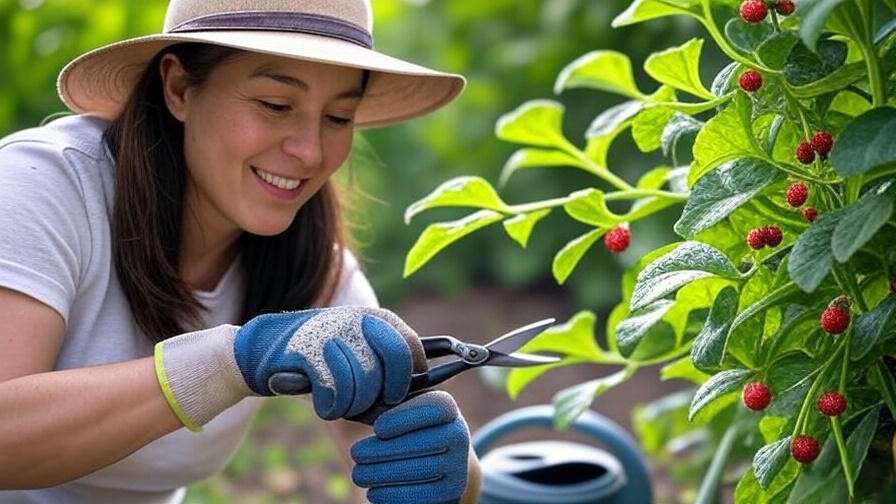
Mulching and Weed Control
Mulch is a Watermelon Berry’s best friend. Apply a 2-inch layer of straw, pine needles, or wood chips around plants to retain moisture, regulate soil temperature, and suppress weeds. Organic mulches also enrich soil as they decompose. Hand-pull weeds promptly to prevent competition for nutrients. Tip: Plant marigolds nearby to deter pests and add a pop of color. For persistent weeds, use a vinegar-based spray, safe for edible crops. 🌿🌾
Protecting Your Watermelon Berry from Pests and Diseases 🐞
Common Pests
Watermelon Berry plants, like all strawberries, can attract pests such as aphids, spider mites, and slugs. Aphids are tiny sap-sucking insects that cluster on new growth, causing leaves to curl. Spider mites, barely visible to the eye, create fine webs and stipple leaves with yellow spots. Slugs, active at night, chew irregular holes in leaves and fruit. Natural Remedies: Spray neem oil (diluted per instructions) to deter aphids and mites, or introduce ladybugs, which are natural predators. For slugs, set up DIY traps using shallow containers filled with beer or grapefruit rinds—slugs crawl in and can’t escape. Companion planting with marigolds or garlic also repels pests naturally. Example: Place a halved grapefruit near plants overnight; by morning, it’ll be slug central! 🐛🌼🍺
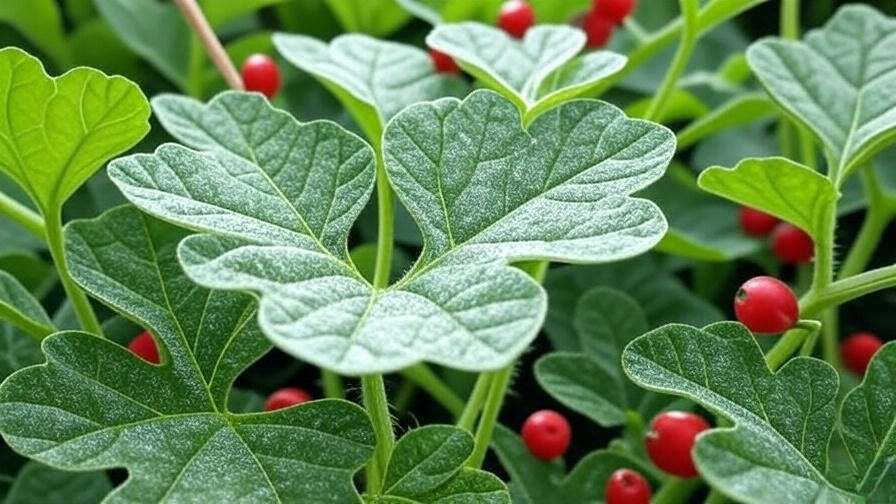
Disease Prevention
Common diseases affecting Watermelon Berries include powdery mildew (white patches on leaves), root rot (soggy, blackened roots), and verticillium wilt (wilting despite adequate water). Prevent these by ensuring proper spacing (15–18 inches) for air circulation and avoiding overhead watering. Rotate crops every 3–4 years to reduce soil-borne pathogens. Expert Advice: Choose disease-resistant varieties like ‘Mara des Bois’ and monitor soil drainage closely—standing water is a recipe for root rot. If powdery mildew appears, apply a baking soda spray (1 tsp per quart of water) weekly. Pro Tip: Sterilize tools with rubbing alcohol between uses to prevent disease spread. 🦠🔍
Seasonal Protection
In colder climates (USDA zones 4–6), winterize Watermelon Berry plants by covering them with a 4-inch layer of straw or pine needle mulch after the first frost. For container plants, move pots to a garage or sheltered area. In hot climates (zones 8–9), use shade cloth during heatwaves to prevent leaf scorch and increase watering frequency. Example: A simple burlap cover can protect plants from harsh winter winds while allowing breathability. Check plants monthly during dormancy for signs of pests or rot. ❄️☀️
Harvesting and Enjoying Your Watermelon Berry 🍓
When to Harvest
Watermelon Berries are ready to pick when they display their signature red and white coloration and feel firm yet slightly soft to the touch. The berries should release easily from the stem with a gentle tug. Harvest every 2–3 days during peak season (typically late spring to early fall for everbearing varieties) to encourage continuous fruiting. Tip: Pick in the early morning when berries are cool for the best flavor and shelf life. Store unwashed berries in a breathable container to avoid moisture buildup. Fun Fact: Each plant can yield up to 1 pound of berries per season with proper care! 🫐🌅
Storing and Using Your Berries
Fresh Watermelon Berries last up to 5 days in the refrigerator (store at 32–35°F in a perforated plastic bag). For longer storage, freeze berries whole on a tray, then transfer to an airtight container for up to 6 months. Use them in smoothies, jams, or fresh salads for a burst of flavor. Recipe Idea: Blend Watermelon Berries with yogurt, banana, and a sprig of mint for a refreshing summer smoothie. For a gourmet touch, pair with basil in a caprese-inspired salad. Pro Tip: Rinse berries just before eating to preserve texture. 🧊🥗
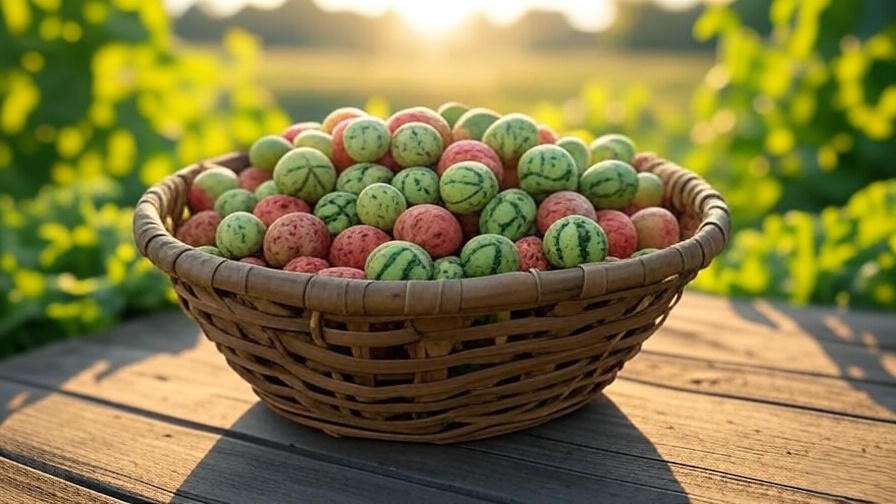
Maximizing Yield Year-Round
To extend the growing season, use row covers or cloches to protect plants from early frosts, allowing fruiting into late fall. In mild climates, a small greenhouse can keep plants productive year-round. Propagate runners by pinning them to soil-filled pots until roots form, then transplant to create new plants. Example: A single healthy Watermelon Berry plant can produce 3–5 runners per season, each capable of becoming a new fruit-bearing plant. Regular fertilization and pruning ensure consistent yields. 🌱🏠
Troubleshooting Common Watermelon Berry Problems 🛠️
Why Aren’t My Plants Fruiting?
If your Watermelon Berry plants aren’t producing fruit, check for these culprits: insufficient sunlight (less than 6 hours daily), poor soil nutrients, or excessive runner growth. Move plants to a sunnier spot, apply a balanced fertilizer, and trim runners to redirect energy to fruiting. Pests like aphids or diseases like powdery mildew can also reduce yields—inspect plants closely. Solution: Conduct a soil test (kits available online for $15–20) to confirm nutrient levels and adjust with compost or fertilizer as needed. 🔍🚫
Yellowing Leaves or Wilting Plants
Yellowing leaves often signal overwatering, nutrient deficiency, or disease. Check soil moisture—soggy soil indicates overwatering, while dry, crumbly soil suggests underwatering. A nitrogen deficiency can cause yellowing; apply a high-nitrogen fertilizer like fish emulsion. Wilting despite adequate water may point to root rot or verticillium wilt. Fix: Improve drainage by adding perlite to soil and reduce watering frequency. For suspected disease, remove affected plants and avoid replanting strawberries in the same spot for 3 years. 🥀✅
Expert Q&A
Q: Can I grow Watermelon Berry indoors?
A: Yes! Place plants near a south-facing window with 6–8 hours of sunlight or use a grow light (12–16 hours daily). Ensure pots have drainage and maintain consistent moisture.
Q: Why are my berries small?
A: Small berries can result from insufficient water, poor pollination, or overcrowding. Hand-pollinate with a small brush or plant bee-attracting flowers like lavender nearby. Expert Insight: Horticulturist Dr. Jane Smith recommends checking soil pH annually, as fluctuations can stunt fruit development. 🧑🌾❓
FAQs About Growing Watermelon Berry 🌟
Q1: How long does it take for Watermelon Berry to produce fruit?
A: Everbearing varieties like Watermelon Berry typically produce fruit 4–6 weeks after planting, with peak production in summer. ⏳
Q2: Can Watermelon Berry grow in shade?
A: They tolerate partial shade but produce the best fruit in full sun (6–8 hours daily). In shady spots, expect smaller yields. ☀️
Q3: Are Watermelon Berries safe for pets?
A: Yes, the berries are non-toxic to dogs and cats, but overconsumption may cause mild stomach upset. Monitor pets around plants. 🐶
Q4: How do I overwinter my Watermelon Berry plants?
A: Apply a 4-inch mulch layer or move container plants to a sheltered area. Water sparingly during dormancy to prevent root rot. ❄️
Q5: What’s the best companion plant for Watermelon Berry?
A: Marigolds or borage deter pests and attract pollinators, boosting fruit production. Plant them 12 inches from berries. 🐝
Conclusion: Your Journey to a Thriving Watermelon Berry Garden 🌈
Growing Watermelon Berry plants is a delightful way to bring beauty and flavor to your garden, whether you’re working with a sprawling backyard or a cozy balcony. By following these expert-backed tips—choosing the right variety, optimizing soil and sunlight, and staying vigilant against pests—you’ll enjoy vibrant yields season after season. Start small, experiment with containers or raised beds, and don’t be afraid to propagate runners for an ever-expanding berry patch. Call to Action: Share your Watermelon Berry growing tips or favorite recipes in the comments below! For more gardening inspiration, check out our guides on strawberry care and container gardening. Happy planting! 🌱💬













